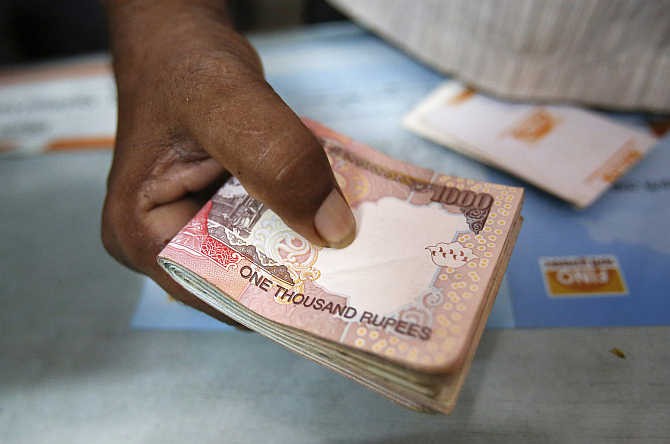7 Reasons why India is staring at a currency crisis
Post on: 16 Март, 2015 No Comment

More From Forex
Forex Reserves Jump $16.4 Billion in First 9 Months of FY’15: RBI
RBI Buys $12.2 Billion From Markets in January
Rupee to Depreciate Marginally in 1 Year: Poll
Euro Hits Over 11-Year Low, Bonds Rise After ECB
In my previous column. when the rupee was trading at 65 against the US dollar I had written about how the rupee might reach 70 against the dollar in the near future and why the rupee has depreciated so much recently.
The Indian economy is in a dangerous position today and the situation can potentially spiral out of control. Heres how.
A current account deficit occurs when a country is importing more goods and services than it is exporting (if the reverse was true, it would be in a surplus). Indias current account deficit has exploded 1125 per cent since 2007, going from $8 billion to $90 billion. In other words, India is importing $90 billion more than it is exporting.
However, in 2007, India had $300 billion in foreign exchange reserves. It could cover its current account deficit 37.5 times over. Currently, Indias foreign exchange reserves have gone down to $275 billion: it can only cover its current account deficit 3 times.
Indias current account deficit has grown steadily throughout the past 5 years: it did not just balloon up overnight. Since many of the countries that trade with India only accept foreign currencies in return (mainly the greenback), it would seem obvious for India to continuously maintain a growing stockpile of foreign reserves through the years; alas, India did not do that. Its no wonder that Prime Minister Manmohan Singh tried to reassure the country that unlike 1991 when the country only had foreign exchange reserves for 15 days of imports. now we have reserves for seven months. 7 months before we run out of reserves? That hardly sounds reassuring. (Also read. PM highlights bright side of crashing rupee )
Here is where the situation can begin to sound grave. The US economy, 5 years post the 2008 financial crisis, is starting to make an economic emergence. When a countrys economy is growing, interest rates start to go up, and the country starts printing less money than required. We are now sitting on a dangerous situation where, not only is the rupee depreciating heavily against the dollar, but the supply of dollars is likely to shrink in the coming months. We emphasized the need for US dollars in order to keep the currency account deficit in check. This puts an additional burden on the rupee.
Furthermore, two additional factors will be at play here. Firstly, the push in interest rates in the United States and overseas creates higher incentives for international investors to invest abroad versus India. Already, the impact is being felt. Since March of this year, foreign exchange reserves have already dropped by $14 billion due to investors opting to invest in the US and other countries versus India.
Secondly, it is important to note that a current account deficit cannot be labeled as bad just because it is not a current account surplus. After all, most developed countries run high current account deficits. A high current account deficit can be required if a country is growing and requires imports to fuel growth. A way to measure the health of a current account deficit is to compare it to the countrys GDP. Academic studies suggest that a current account deficit which is 2.5 per cent of a countrys GDP is sustainable.
What makes Indias situation dangerous is that it is currently at almost 5 per cent of its GDP. Furthermore, economists polled around the world are expecting Indias GDP to drop even further this fiscal year.
What does this all mean? Ultimately, the faith the marketplace places on its economy is what gives it reassurance. Sentiments run the market. What are the current signs pointing to?
1. Rupee weakness
Further weakening of the rupee due to a lower supply of dollars and higher interest rates abroad.
Economists predicting a lower GDP for the current fiscal year, a disastrous sign since we just witnessed a GDP drop from 6.2% to 5% from the last fiscal year to the current fiscal year.
3. Current account deficit
A further rise in Indias current account deficit.

4. Foreign reserves
The government signaling that within months it might run out of foreign reserves.
5. Short-term debt
$170 billion in short-term debt to pay, while in 2008 it was just $80 billion.
6. FII investment
From May to August 2013, FII investments in India having gone down by $2 billion.
Both the private and public sectors staying clear on investment strategies until next years elections.
When taking all of this into account, it will require a heroic effort by the newly appointed RBI governor, Raghuram Rajan, to prevent a currency crisis from unfolding.
Raghu Kumar is the co-founder of RKSV, a broking company. The opinions expressed here are the personal opinions of the author. NDTV is not responsible for the accuracy, completeness, suitability or validity of any information given here. All information is provided on an as-is basis. The information, facts or opinions appearing on the blog do not reflect the views of NDTV and NDTV does not assume any responsibility or liability for the same.
Story first published on. August 31, 2013 16:01 (IST)














